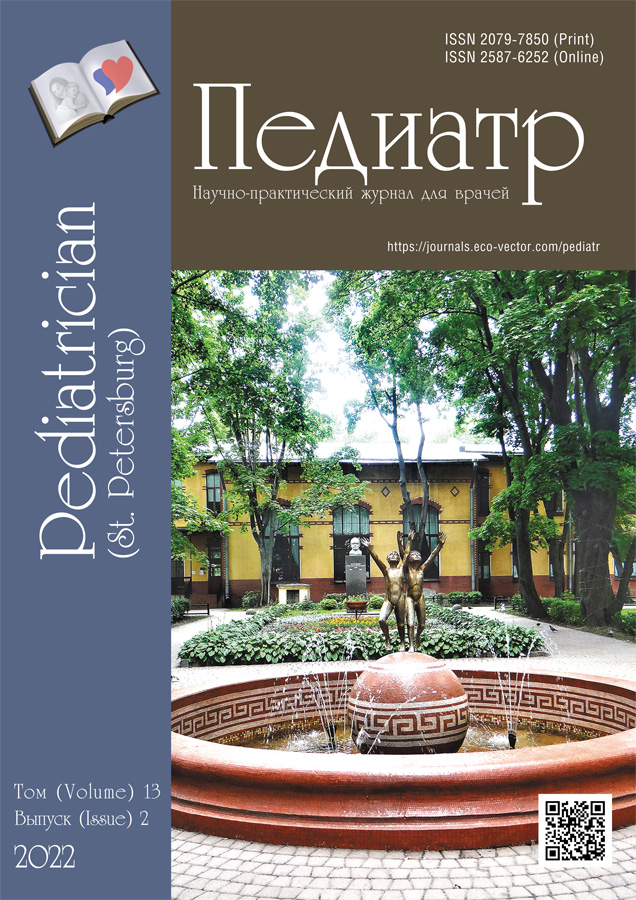State of liver functional activity in children with atopic dermatitis
- Authors: Buryak V.N.1, Antonova T.I.2, Dudko M.V.2, Shepelenko K.K.2, Malysheva I.V.2
-
Affiliations:
- North-Western State Medical University named after I.I. Mechnikov
- Children’s City Polyclinic No. 35 of the Moscow District, Center for Rehabilitation Treatment of Children with Allergic Diseases
- Issue: Vol 13, No 2 (2022)
- Pages: 35-41
- Section: Original studies
- URL: https://journals.eco-vector.com/pediatr/article/view/109257
- DOI: https://doi.org/10.17816/PED13235-41
- ID: 109257
Cite item
Abstract
BACKGROUND: The problem of atopic dermatitis today remains one of the unsolved problems of pediatrics and pediatric allergology. Among the etiopathogenetic mechanisms of atopic dermatitis, the role of endo-allergens formed as a result of impaired digestion and absorption processes in the gastrointestinal tract of a child is separately noted. In such conditions, the load on the detoxification function of the liver increases. In connection with this circumstance, the study of the functional activity of the liver in children with atopic dermatitis is of particular interest. One of its criteria is the nature of intrahepatic hemodynamics.
AIM: To find out the features of intrahepatic hemodynamics in the development of atopic dermatitis in children.
MATERIALS AND METHODS: 83 children aged 6 months to 5 years with a diagnosis of atopic dermatitis, who made up the main research group, and 33 practically healthy children of the same age, who formed a control group, were examined. The nature of heredity for allergic pathology and morbidity of the gastrointestinal tract was found out in all patients. To obtain information about the functional activity of the liver in all children, hepatic blood flow in the hepatic artery and hepatic vein was studied.
RESULTS: Violation of intrahepatic hemodynamics was revealed in children with atopic dermatitis. The blood flow in the hepatic artery in them was characterized by a decrease, and the blood flow in the hepatic vein was characterized by an increase in speed indicators. The detected violations of intrahepatic hemodynamics in children with atopic dermatitis are regarded by the authors of this study as a manifestation of a decrease in the functional activity of hepatocytes in conditions of increased allergenic load.
CONCLUSIONS: The study clearly demonstrated a violation of the functional state of hepatocytes in children suffering from atopic dermatitis, expressed in the suppression of hepatic hemodynamics. The question of the primary or secondary nature of this violation is the subject of discussion and further scientific research.
Full Text
About the authors
Vladimir N. Buryak
North-Western State Medical University named after I.I. Mechnikov
Email: vladimir.buryak@inbox.ru
MD, PhD, Dr. Med. Sci., Professor, Department of Pediatrics and Pediatric Cardiology
Russian Federation, Saint PetersburgTatyana I. Antonova
Children’s City Polyclinic No. 35 of the Moscow District, Center for Rehabilitation Treatment of Children with Allergic Diseases
Email: antian@bk.ru
MD, PhD
Russian Federation, Saint PetersburgMaria V. Dudko
Children’s City Polyclinic No. 35 of the Moscow District, Center for Rehabilitation Treatment of Children with Allergic Diseases
Author for correspondence.
Email: maria.dudko17@gmail.com
allergist-immunologist
Russian Federation, Saint PetersburgKirill K. Shepelenko
Children’s City Polyclinic No. 35 of the Moscow District, Center for Rehabilitation Treatment of Children with Allergic Diseases
Email: shess08@inbox.ru
allergist-immunologist
Russian Federation, Saint PetersburgInna V. Malysheva
Children’s City Polyclinic No. 35 of the Moscow District, Center for Rehabilitation Treatment of Children with Allergic Diseases
Email: inness6996@yandex.ru
allergist-immunologist
Russian Federation, Saint PetersburgReferences
- Baranov AA, Namazova-Baranova LS, Khaitov RM. Allergologiya i immunologiya: Soyuz pediatrov Rossii. 2-e izd., ispr. i dop. Moscow: Soyuz pediatrov Rossii, 2018. 492 p. (In Russ.)
- Bel’mer SV, Kornienko EA. Organy pishchevareniya kak mishen’ allergicheskogo protsessa. Praktika pediatra. 2019;(2):66–73. (In Russ.)
- Soyuz pediatrov Rossii, Rossiiskaya assotsiatsiya allergologov i klinicheskikh immunologov, Rossiiskoe obshchestvo dermatovenerologov i kosmetologov. Atopicheskii dermatit u detei: klinicheskie rekomendatsii. Moscow: Ministerstvo zdravookhraneniya RF, 2016. 60 p. (In Russ.)
- Ksenzova LD. Atopic march. Risk of developing of allegic rinitis and bronchial asthma in children with atopic dermatitis. Allergology and Immunology in Pediatrics. 2018;(4):25–29. (In Russ.)
- Lagutina SN, Chizhkov PА, Lushchik МV, Makeeva AV. Allergic reactions as one of the main problems of modern medicine. Mezhdunarodnyi studencheskii nauchnyi vestnik. 2018;(4–4):614–617. (In Russ.)
- Landsberg GS. Ehlementarnyi uchebnik fiziki. Moscow: Nauka, 1973. 655 p. (In Russ.)
- Samtsov AV, Khairutdinov VR, Belousova IE. Etiopathogenetic therapy of inflammatory dermatoses. Vestnik dermatologii i venerologii. 2018;94(2):78–83. (In Russ.) doi: 10.25208/0042-4609-2018-94-2-78-83
- Giuffrè M, Campigotto M, Campisciano G, et al. A story of liver and gut microbes: How does the intestinal flora affect liver disease? A review of the literature. Am J Physiol Gastrointest Liver Physiol. 2020;318(5): G889–G906. doi: 10.1152/ajpgi.00161.2019
- Mernelius S, Carlsson E, Henricson J, et al. Staphylococcus aureus colonization related to severity of hand eczema. Eur J Clin Microbiol Infect Dis. 2016;35: 1355–1361. doi: 10.1007/s10096-016-2672-2
- Stalder J-F, Fluhr JW, Foster T, et al. The emerging role of skin microbiome in atopic dermatitis and its clinical implication. J Dermatol Treat. 2019;30(4):357–364. doi: 10.1080/09546634.2018.1516030
Supplementary files









